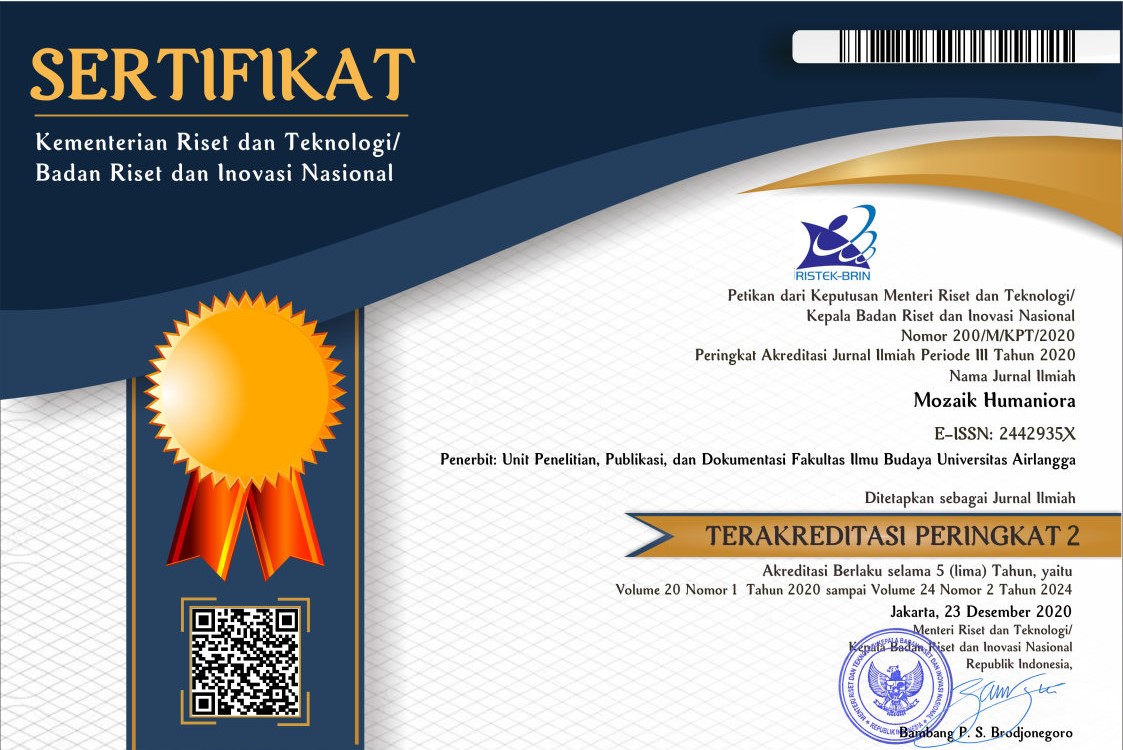Students' Perceptions of Innovative Learning Media as a Support System for Inclusive Education
Downloads
All students, without exception, are expected to have an equal opportunity of acquiring higher education. Many universities in Indonesia including Universitas Airlangga accept students with disabilities. However, the availability and use of learning materials for these students are scarce. The study aimed to understand the students' perceptions on this issue, particularly for students with visual and hearing impairments. The study includes 80 participants consisting of regular students and students with special needs in Universitas Airlangga. The study used a questionnaire to collect students' perspective on learning media provided by Universitas Airlangga. The findings of the study revealed how the majority of students at Universitas Airlangga considered learning materials and media available cannot be used to its full potential by students with special needs. Moreover, the policies have not been adjusted to the needs of students with special needs. Moreover, students expected support system to help the learning process of students with special needs. Lastly, the participants' responds on the questionnaire show positive opinions on the initiative and calls for the need to scale up and improve the support system.
Achyar. 2018. "Permasalahan Pendidikan Inklusif di Indonesia.” https://p4tktkplb.kemdikbud.go.id/permasalahan-pendidikan-inklusif-di-indonesia/.
Amalia, Y. S. 2019. Dasar-dasar Pengenalan tentang Massive Open Online Course (MOOC). Surabaya: Airlangga University Press.
Aspers, P. & U. Corte. 2019. "What is Qualitative in Qualitative Research.” Qualitative Sociology 42 (2): 139”160. DOI: https://doi.org/10.1007/s11133-019-9413-7.
Badan Pusat Statistik. 2020. Statistik Pendidikan 2020. Badan Pusat Statistik. https://www.bps.go.id/publication/2020/11/27/347c85541c34e7dae54395a3/statistik-pendidikan-2020.html.
________. 2021. Statistik Pendidikan 2021. Badan Pusat Statistik. https://www.bps.go.id/publication/2021/11/26/d077e67ada9a93c99131bcde/statistik-pendidikan-2021.html.
Bajaj, G. 2019. "Revisiting Visual Impairment.” In Disability, Inclusion, and Inclusive Education, edited by S. Chennat Springer. DOI: https://doi.org/10.1007/978-981-15-0524-9_7.
Denzin, N. K. & Y. S. Lincoln. 2018. "1. Introduction: The Discipline and Practice of Qualitative Research.” In The SAGE Handbook of Qualitative Research, edited by N. K. Denzin & Y. S. Lincoln. SAGE Publications, Inc.
Fatimah, C., D. Parinata, A. Efendy, & Y. Santika. 2021. "Digital Mathematics Learning Companion (DMLC): Aplikasi Android Guru Pendamping Khusus Matematika Bagi Penyandang Tunanetra Berbasis Suara.” Jurnal Ilmiah Matematika Realistik 2 (1): 40”46. DOI: https://doi.org/10.33365/ji-mr.v2i1.1068.
Fitria, H. Kurniawan & M. A. E. Ya. 2017. "Model Analisis Sistem Aplikasi Media Ajar Online sebagai Strategi Penguatan Daya Saing Sumber Daya Manusia. E-Proceedings KNS&I STIKOM Bali. DOI: http://knsi.stikom-bali.ac.id/index.php/eproceedings/article/view/10.
Kartono, G., Mesra, & A. C. K. Azis. 2020. "Pengembangan Media Ajar Grafis Komputer Materi WPAP dalam Bentuk E-Book dan Video Tutorial bagi Mahasiswa Seni Rupa.” Gorga: Jurnal Seni Rupa 1: 127”132. DOI: https://doi.org/10.24114/gr.v9i1.18191.
Kosasih, E. 2021. Pengembangan Bahan Ajar. Jakarta: Bumi Aksara. https://books.google.co.id/books?id=UZ9OEAAAQBAJ&printsec=frontcover&hl=id#v=onepage&q&f=false.
Murtiningsih. 2020. "Penyuluhan Kesehatan Pola Hidup Sehat secara Daring Menggunakan Zoom dan Youtube sebagai Media Ajar pada Masa Pandemi COVID-19.” Jurnal Pengabdian Nasional (JPN) Indonesia 1 (2): 37”40. DOI: https://doi.org/10.35870/jpni.v1i2.13.
Pradnyanita, A. A. S. I. & M. A. Hanindharputri. 2020. "Perancang Video Tutotial Interpreter untuk Mahasiswa Berkebutuhan Khusus (Tuna Rungu) di Sekolah Tinggi Desain Bali.” Jurnal Strategi Desain & Inovasi Sosial 1 (2): 147”156. DOI: http://dx.doi.org/10.37312/jsdis.v1i2.2331.
Rohaeti, E. E., R. Amelia, N. Rukanda, D. S. Fauziya, I. Siliwang, J. Cimahi, & I. Barat. 2021. "Team Teaching Model (TTM) Berbasis Learning Management System (LMS) pada Mahasiswa Disabilitas Netra.” Jurnal Ilmiah P2M STKIP Siliwangi 8 (1), 15”22. DOI: https://doi.org/10.33365/ji-mr.v2i1.1068.
Singh, S. 2019. "Revisiting Inclusion of Children with Hearing Impairment: Issues and Possibilities.” In Disability, Inclusive, and Inclusive Education, edited by S. Chennat. Springer.
Smith, D. G. 2020. Diversity's Promise for Higher Education: Making it Work. Baltimore: Johns Hopkins University Press. https://eric.ed.gov/?id=ED607977.
Suarsana, I. M., I. G. W. Sudatha, G. A. Mahayukti, I. W. E. A. Suandana, & I. G. P. Suharta. 2021. "Implementation of Cognitive Theory in Developing Measurement Learning Multimedia for Deaf Students.” Jurnal Pendidikan dan Pengajaran 54 (3): 425”2433.. DOI: https://doi.org/10.23887/jpp.v54i3.38700.
Unicef. (2017). Inclusive Education: Including children with disabilities in quality learning: what needs to be done? https://www.unicef.org/eca/sites/unicef.org.eca/files/IE_summary_accessible_220917_brief.pdf.
United Nations. (n.d.). Committee on the Rights of Persons with Disabilities. United Nations Human Rights Office of the High Commissioner. https://www.ohchr.org/en/hrbodies/crpd/pages/conventionrightspersonswithdisabilities.aspx#:~:text=Persons%20with%20disabilities%20include%20those,an%20equal%20basis%20with%20others.
Wati, L. A., Gunarhadi, & Asrowi. 2021. "The Effectiveness of the Career Guidance Module to Improve Career Maturity for Children with Special Needs in Inclusive Vocational High Schools.” Jurnal Pendidikan dan Pengajaran 54 (1): 106”115. https://doi.org/10.23887/jpp.v54i1.
Yulian, R. & U. Ruhama. 2021. "Academic Technology Experience and Preference on Online Learning in Higher Education Institutions: Students' Perspectives.” Jurnal Pendidikan dan Pengajaran 54 (3): 508”519. DOI: https://doi.org/10.23887/jpp.v54i3.38322.
Copyright (c) 2022 Yuni Sari Amalia

This work is licensed under a Creative Commons Attribution-ShareAlike 4.0 International License.

Mozaik Humaniora is licensed under a Creative Commons Attribution-ShareAlike 4.0 International License. Both authors and Mozaik Humaniora agree with the following attribution of journal:
1. Copyright of this journal is possession of Author, by the knowledge of the Editorial Board and Journal Manager, while the moral right of the publication belongs to the author.
2. The journal allows the author(s) to retain publishing rights without restrictions
3. The legal formal aspect of journal publication accessibility refers to Creative Commons Attribution Share-Alike (CC BY-SA).
4. The Creative Commons Attribution Share-Alike (CC BY-SA) license allows re-distribution and re-use of a licensed work on the conditions that the creator is appropriately credited and that any derivative work is made available under "the same, similar or a compatible license”. Other than the conditions mentioned above, the editorial board is not responsible for copyright violation.


















